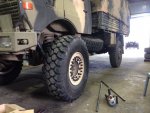- 1,450
- 123
- 63
- Location
- Gray, GA
I'll make a couple of points.Thanks for the advice Gents. I guess I can try a combination of compressing the run flats using a ratchet and also use the engine hoist to pull them gently out.
Hmmmmm, now I am confused as to whether I should leave them in or not? Sounds like there can be a safety benefit in having them but, fuel costs will add up over the years and acceleration may be reduced due to the mass. One writer even suggested that they will wear out the tyres from the inside very quickly (thats a worry when the tyre costs about $1800)? Do I need to regularly re grease them to stop them wreaking the tyres? Why would they even put grease in them unless they tend to rotate inside the tyre. If thats so, then they 'will' eventually wreck the tyre from the inside. Perhaps for the military its a trade off between shortened lifespan and extra safety that they can afford?. As a civilian, soon to retire, I wont be able to afford a second set of tyres. As I will be fitting pressure and temperature monitors and driving within the G speed rating, hopefully I wont get a blow out?
The runflat never touches the tire unless the tire is flat. No extra wear to the tire will be caused by the runflat when the tire is inflated.
The military runflat in the 395/85R20 tires weighs about 150# each. It would use more fuel to get them moving, but would use less fuel once they are moving because of the momentum gained from the extra weight through centrepital force. Consider how a heavier flywheel takes longer to stop turning than are lighter one, of the same diameter. The fuel cost will be mostly negated.
The extra 600# from 4 runflats on a 4 wheeled vehicle is added at the very lowest point on the vehicle. This can only help on the stability side of things.
The tire, and the belts inside, were not designed to support a load with a solid object compressing it from the inside and the outside. It was designed to support the load with air on the inside and the ground on the outside. The runflat is considered a solid object even though it is rubber. The excess flexing and weight put on the tread portion of the tire causes belt damage, whether obvious or not. I personally would not reuse a tire that had been driven flat, with or without a runflat. Civilian tire shops that deal with runflats don't either.
On a 395/85R20 the distance from the rim lip to the ground is roughly 11". That would be the distance that the end of the axle dropped during a blowout. The runflat will cut that distance by at least half. On the front axle, the less the suspension changes at speed, the less it will affect steering. This is a huge benefit for steer tires.
I've broken down 9 new MRAP tire/wheel assemblies with runflats so far to change out the valve stems to something compatible with my truck. The date codes spanned over a 6 year period and none had any lube in them at all. I prefer it that way since I would replace the tire driven on the runflat anyways as I stated above. No need for all that mess when breaking down a tire. For extended driving on just a flat tire, not a blowout, a runflat will need lube because the rubber on rubber contact will create heat. I just want to limp to a place to change the tire and I won't be reusing it anyways.
Some personal preference mixed in but hope this helps. I would keep them. Once you take them out, you'll never get them back in if you change your mind.
Last edited:



